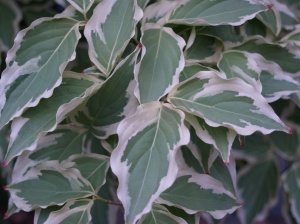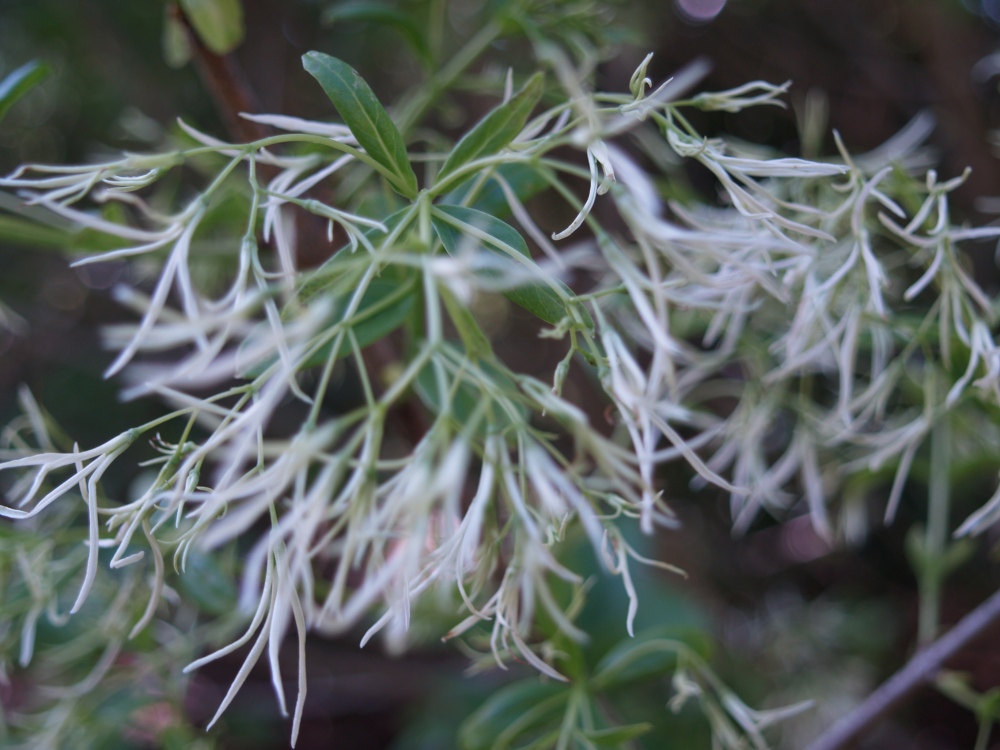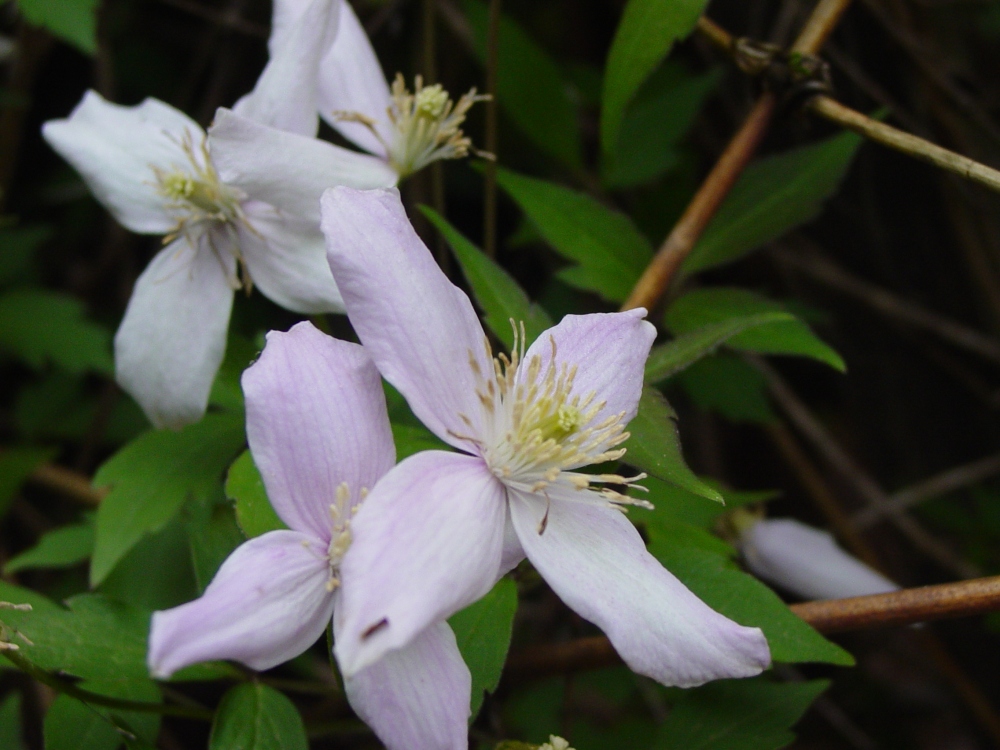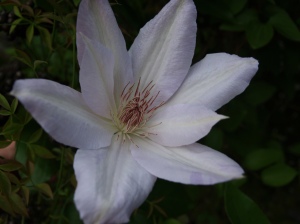After nine or ten days of rain, and scarcely a glimpse of the sun during that time, sunny days have returned. Though the temperatures are cool, with nighttime lows in the forties, blooming plants have picked up the pace. There are flowers popping out all over the garden, and buds that will open in days on many others.
We had family visit over the weekend, and it was pointed out to me that some of the paths through the garden are completely blocked. (It happens every other year, why would this year be a surprise?) The large leafed hostas haven’t fully opened yet, but they cascade over the uphill path on the side yard. I told my mother that our garden snakes lurk there. She was not amused, but she did follow the group pushing through the still damp hostas and nandinas.
I was cutting back some dead wood on a grouping of hydrangeas the day before, kneeling down, looked up for a moment, eye to eye with a snake. Not a big one, about the thickness of a finger, but a foot and a half long. I’m not a screamer, but I was a bit startled, as was the snake. He scurried away, as did I. There have been more numerous encounters this Spring than usual, which I have no explanation for.
Though I’m not fond of snakes, I tolerate them in the garden since they’ve not done harm as far as I can tell. A few years ago they were caught in the act snatching goldfish from one of the ponds, but now the koi are much too large for these small snakes.
We’ll hurry away from this snake discussion back to the flowers and foliage that make the garden such a delight in mid May. The native dogwood blossoms dropped in a huff during downpour more than a week ago, but now the Rutgers dogwoods are blooming. Stellar Pink, a misnomer to me since its blossoms rarely have pink of any substance, is flowering and will for several weeks, a week longer than the native. It is open branched and more upright than the native, but I think a valuable addition to the garden.
 As the Rutgers dogwoods (developed at Rutgers University) fade in a couple weeks, the Chinese dogwood, Cornus kousa will begin to bloom. Until then, the leaves of variegated leaf kousa varieties Wolf Eyes (above) and Samaritan (left) are nearly as ornamental as the flowers, and in fact the flowers don’t show well above the green and white leaves. The green and yellow variegated Cherokee Sunset dogwood (below) with dark pink or red blossoms is quite slow growing, but a beautiful small tree with flowers before the leaves appear.
As the Rutgers dogwoods (developed at Rutgers University) fade in a couple weeks, the Chinese dogwood, Cornus kousa will begin to bloom. Until then, the leaves of variegated leaf kousa varieties Wolf Eyes (above) and Samaritan (left) are nearly as ornamental as the flowers, and in fact the flowers don’t show well above the green and white leaves. The green and yellow variegated Cherokee Sunset dogwood (below) with dark pink or red blossoms is quite slow growing, but a beautiful small tree with flowers before the leaves appear. 
 The redbuds are past bloom by several weeks, but the red leafed Forest Pansy (at left) is at its prime now. The new leaves look like glossy wet paint. The leaves on Silver Cloud redbud are not large enough to show off their coloration. Give them another week and the leaves look like flowers from a distance.
The redbuds are past bloom by several weeks, but the red leafed Forest Pansy (at left) is at its prime now. The new leaves look like glossy wet paint. The leaves on Silver Cloud redbud are not large enough to show off their coloration. Give them another week and the leaves look like flowers from a distance. 
Also in its glory now is the Fringetree, Chionanthus virginicus (above). The ribbony flowers on this native tree are quite short lived, but they are a wonder while they last. I have several trees, one a single trunk that sends suckers every year wanting to be multi-trunked, and the others with multiple trunks. Both are pest free and undemanding, excellent trees for a small garden or a small space in a large garden.
 The first flower on the Red Knockout Rose appeared today. The Pink, Rainbow, and Sunny will soon follow. Rainbow has been a disappointment with poor foliage and some disease problems, but the others bloom from now (mid-May) almost to Thanksgiving with very little of the problems typical to roses. I’m not willing to spray plants to prevent fungus or pests that are common to roses, so they were banned from my garden until the disease resistant varieties were introduced, starting with Flower Carpet roses. Though Flower Carpets have performed far worse than promised, the marketing for Knockout roses has been understated. I’m certain that they are scorned by rosarians as too common, but for the rest of us who enjoy a long blooming, low care plant, Knockouts are as good as any flowering shrub.
The first flower on the Red Knockout Rose appeared today. The Pink, Rainbow, and Sunny will soon follow. Rainbow has been a disappointment with poor foliage and some disease problems, but the others bloom from now (mid-May) almost to Thanksgiving with very little of the problems typical to roses. I’m not willing to spray plants to prevent fungus or pests that are common to roses, so they were banned from my garden until the disease resistant varieties were introduced, starting with Flower Carpet roses. Though Flower Carpets have performed far worse than promised, the marketing for Knockout roses has been understated. I’m certain that they are scorned by rosarians as too common, but for the rest of us who enjoy a long blooming, low care plant, Knockouts are as good as any flowering shrub.
Hanging out by the swimming pond with the family over the weekend I saw that the buds of many of the irises were swelling. The Japanese iris are a week or two from blooming, but the Yellow Flag, Iris pseudoacorus, bloomed the next day, and the dark purple Ceasar’s Brother will likely unfold later today or tomorrow. The yellow flag are planted in gravel (no soil except silt) in several inches of water in the filtration area of the big pond. They are called an invasive aquatic by some groups, but mine are spreading quite slowly, probably because the gravel limits them. They bloom only a short period, but are delightful, and the upright sword-like leaves naturalize the pond margins. I prefer the Japanese iris with their longer lasting, larger, and more colorful blooms, but both are quite nice. 
 Clematis have popped into bloom. Prolific in flower and growth, Montana rubrum blankets the railing and lattice beneath my deck. There are thousands of blossoms, followed by aggressive growth that is a bit of chore to keep in bounds, but manageable compaired with other vines that came before in this spot. Other clematis are much more tame, growing slowly up through the tall nandinas they are trained onto for support. Though they have far fewer blooms, they work perfectly in this situation. The large flowers make a show, but the vine recedes into the background afterward.
Clematis have popped into bloom. Prolific in flower and growth, Montana rubrum blankets the railing and lattice beneath my deck. There are thousands of blossoms, followed by aggressive growth that is a bit of chore to keep in bounds, but manageable compaired with other vines that came before in this spot. Other clematis are much more tame, growing slowly up through the tall nandinas they are trained onto for support. Though they have far fewer blooms, they work perfectly in this situation. The large flowers make a show, but the vine recedes into the background afterward.
 And finally, a new purchase in bloom, Peruvian lily, Alstromeria, often seen in floral arrangements, has wonderful flowers, a long period of bloom as long as it is sheltered for cooler Summer temperatures, and is hardy below zero Fahrenheit as long as it’s well mulched. I rarely pay attention to take care of those details in the Fall, and cold sneaks up on me, but this one is worth the effort.
And finally, a new purchase in bloom, Peruvian lily, Alstromeria, often seen in floral arrangements, has wonderful flowers, a long period of bloom as long as it is sheltered for cooler Summer temperatures, and is hardy below zero Fahrenheit as long as it’s well mulched. I rarely pay attention to take care of those details in the Fall, and cold sneaks up on me, but this one is worth the effort.
This weekend I’m headed south to visit the eldest son in grad school in Athens, Georgia. I hope to make some time to visit the arboretum. No doubt there will be many chores to catch up on, and much to see when we return next week.
The rose that you mentioned that you can’t remember the name of: Playboy?
I believe I have the same as an ornamental one stem in my front garden. It flowers “orangey” then turns pink.
Cheers